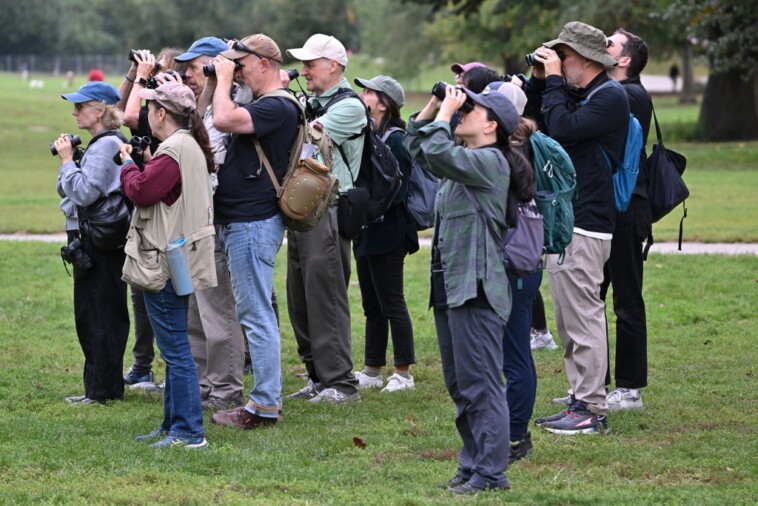Hold onto your binoculars.
Feathers will fly in the skies over New York City this weekend — as hundreds of thousands of birds pass through the Big Apple on their way south for the winter during a major spike in migration.
The larger-than-normal avian arrival is leaving bird watchers crowing in anticipation.
“I’m super excited. If someone tells me it’s going to be a great day, it really just gives you that extra push to get out there,” Amy Cook, 56, of Park Slope, told The Post.
About 3,921,500 birds — including bald eagles — have already flown through the Big Apple this autumn migration season, which kicked off in August, according to BirdCast data.
There have been some spikes throughout the last few weeks — including 83,000 birds that crossed Thursday night alone — but birding experts explained that peak migration patterns come in October, especially during noticeable drops in temperature.
A perfect blend of cooler weather and strong winds will likely bring a massive “pulse” of migrating birds on Saturday night.
“There’s going to be this really favorable set of like cooler air temperatures, tailwinds or wind blowing out of the north and west. And that’s what’s in the very most proximate sense, bringing this about,” said Andrew Farnsworth, a scientist in the Center for Avian Population Studies at the Cornell Lab of Ornithology, which collects BirdCast data.
Farnsworth described this migration season as an “odd year,” due in part to the dreary weather the five boroughs suffered through in late September as a byproduct of Hurricane Helene.
Foggy and wet conditions typically keep birds out of the sky — and pose a danger for those that try to continue their migration south.
Between 90,000 and 230,000 migrating birds are killed from striking into buildings every year, according to NYC Bird Alliance data, a shocking total that is up 20% this year. Two of the biggest nights for the fatal strikes occurred on nights with precipitation and cloud cover, leading to poor visibility, said Farnsworth.
The dip in migration won’t affect the overall numbers for the season, which Farnsworth expects to be on par with the last few years, but clears the way for a noticeable pulse this coming weekend, much to the excitement of bird enthusiasts.
About four dozen birders patroled Prospect Park early Thursday morning to catch a glimpse of those migrating birds making a pit stop in the Big Apple to fuel up before continuing their journey to the south.
The thrice-weekly walks, led by the Brooklyn Bird Club, can last as long as seven or eight hours during the fall migration season, board member Tom Stephenson, 74, said.
“The reason the city parks are so amazingly important is because the birds have no other options. At the end of the night, this is it. There’s nowhere else,” the Princeton bird lecturer told The Post, pointing out that the birds follow the coastline during migration.
“Most New Yorkers have no idea. When I talk to civilians in the park, they’re like, ‘Yeah, there are birds in the park, pigeons’ — no! There could be 100 different species in the park in a day.”
On Thursday’s walk, the crew spotted 67 types of birds, including a Bald Eagle, a Red-Tailed Hawk and five species of woodpeckers. Other unusual species that could be seen this weekend include the White-eyed Vireo, Red-breasted Nuthatch, Brown Creeper, Swamp Sparrow, Common Yellowthroat and Yellow-breasted Chat.
Birding has become increasingly popular in recent years, with a noticeable boom coming during the pandemic, Stephenson said.
Cook, who got sucked into the trend in 2021, told The Post she found a serenity in birding as well as a community who have an appreciation for nature.
She recalled the euphoria the collective group experienced during the previous migration where they spotted an American purple gallinule, a southeastern waterfowl rarely seen in New York.
“You’d think Taylor Swift was here!” Cook said.
Mitch Fagan, 36, and partner Chloe M., 31, had been considering picking up the hobby for some time but pounced on the opportunity to attend a bird walk during peak migration month.
“We made it a point to get out here before winter. It’s a great connection to this place,” Fagan, a Portland, Oregon transplant said.
Birding has already proven to be an exhilarating pastime for the couple — the species they’ve spotted are drastically different than the ones they were used to seeing back on the West Coast.
“It’s a major draw for us,” M. added.










